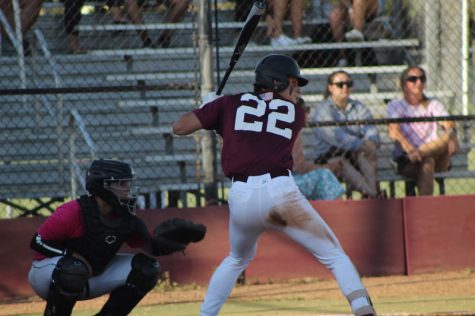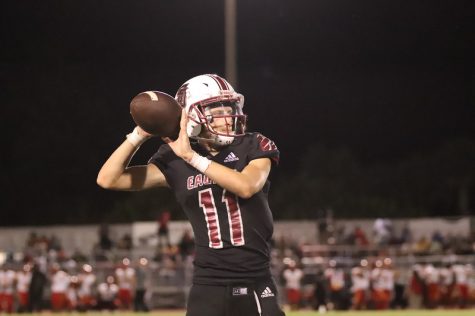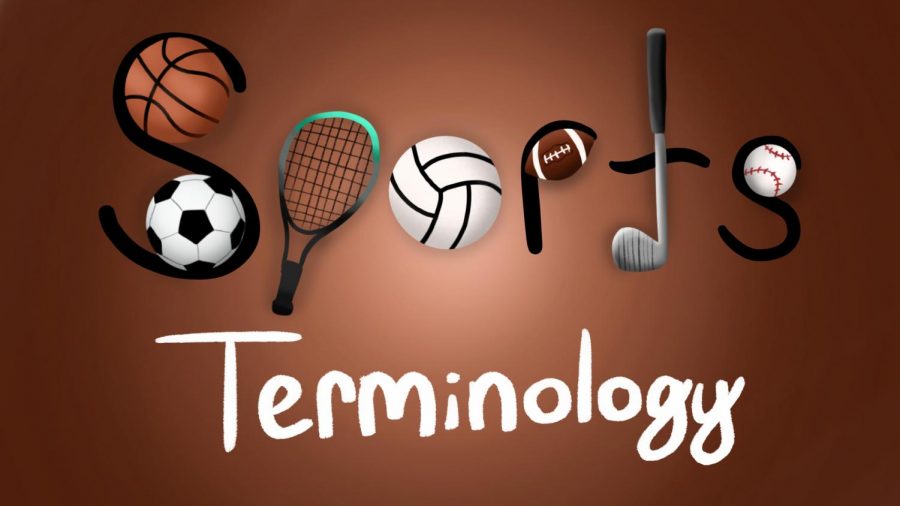Sports terminology identifies the words and phrases commonly used in popular sports
Sports terminology has a lot of use in today’s society but may be hard to decipher to people who aren’t sports fans.
November 1, 2021
In sports, there are many terms that are unfamiliar to the average person. Similar to a foreign language, the terms that athletes speak can be learned and used when people are playing a sport. Specific sport-related terms are essential for participants or viewers to understand a game.
Basketball
Scoring:
Basketball has a wide variety of terms unique to the sport. Most of these terms derive from types of shots, such as field goals, three point shots, mid range shots, layups, and rebounds. A field goal is when the offense shoots the ball and it goes into the basket. Three point shots are when the offensive player shoots from outside the three point line, which is an arc-shaped line near each basket that determines how many points a successful shot is worth. The mid-range shot is when the offensive player shoots from inside the three point line, only counting for two points. Layups are a type of shot in which a player has to advance close to the basket, banking the ball off the backboard to score two points.
Rebounds:
Rebounds are statistical awards given to a player after grabbing the ball after a missed field goal and can differ depending on which side of the court a player is on. Defensive rebounds are when a player on defense catches a rebound after an offensive player shoots and misses. An offensive rebound is when a player misses a shot, and another player of the same team grabs the ball.
Fouls:
Additionally, there are defensive and offensive terms related to players who commit fouls in a game. Players in a game can only have six fouls called on them. On their sixth foul, they will be ejected from the game, in which the player must leave the game immediately for the remainder of play. There are many types of fouls such as flagrant fouls, where if a player were to commit two, they are ejected from the game. A flagrant foul is when there is excessive or aggressive contact with an opponent, a defensive or offensive player can commit these fouls. Another foul that results in ejection from the game when two are committed is a technical foul. A technical foul when there is misconduct with a player, then the opponent is awarded a free-throw, which is a shot where the player is at the free throw line and they shoot at the basket. Then there are team fouls, which is the number of fouls that a team can commit before going over the limit, and their opponent is awarded a free-throw (these fouls can be defensive or offensive). A personal foul is when a player commits contact to injure another player. A blocking foul is a defensive foul when a player tries to block a player’s movement with their body.
Positions:
There are also many different positions in basketball, with the first being the point guard. Players who hold this position are known for running the offense and pointing out the opposing defense’s strategy. They also play on the perimeter of the court while running the offense. The shooting guard is the second position, which takes most of the shots either on the perimeter or in the mid-range area. The small forward is the third position, which mainly involves defense; depending on the size of the player, it could either be perimeter or interior defense. Perimeter defense is when a defender is defending an offensive player on the three point or the mid range. Interior defense is when a defender is defending an offensive player near the rim. The fourth position is the power forward, a defensive position to defend the taller players on the court and rebound the ball. This position plays near the rim. They also take longer shots on the offense. The fifth and last position is the center. The center is very self-explanatory, as the holder of this position is both the centerpiece of the offense and defense. The center position is mostly known for grabbing rebounds and also playing very close to the basket. Though most positions in modern day basketball dont follow one position on the court, depending on how the coach wants to run the offense or defense.
Soccer
Scoring:
Soccer’s basic terminology starts with the goal. A goal is when the offense kicks the ball into the defense’s net. A shot is a term referring to anytime a player attempts to kick toward the opponent’s goal to try to score. A pass is when a player kicks the ball to their teammate. An assist is a pass leading to another teammate scoring.
Defense:
Regarding defensive terms in soccer, a trap is when a defender gains control of the ball and dribbles it. Another way a defender may try to take the ball, like tackling the opponent. Tackling is when a defender approaches their opponent, who possesses the ball, and legally extends their foot to steal the ball. If the defender is considered to have made too much contact during the tackle, they could be fouled. If the same player receives another foul, they receive a yellowcard. Continuing, if a player receives two yellow cards, then they get a red card, which leads to an ejection from the game. After a foul, a player on the opposing team has a free kick in which the team decides on one player to kick the ball as either a pass or a shot on goal. If the ball misses the goal and a player on the defense hits it out of bounds on the goal side, then the offense can have a corner kick, which is when the play is restarted and a player kicks the ball from the corner of the field in an attempt to score. The corner kick depends on which side of the goal the ball went out of bounds on. If the free kick was instead to just simply go out of bounds, then the goalie would then have a goal kick, where they pass the ball to their teammates within the goal area, a box located six yards around the goal posts.
Rules:
Soccer has many rules implemented to keep the game fair. To start, a player cannot touch the ball with their hands, excluding the goalie, who can only touch the ball within the goal area. If a handball is committed in the goal area by a defender, then the offense of the opposing team receives a penalty kick.A penalty kick is when one player from the offense puts the ball at the penalty line, which is located 12 yards from the goal, and shoots at the goal. Then, the goalie tries to defend and keep the ball out of the goal. Another rule-related term is an offside call, which is when a player on the offense passes it to a player that is in front of the defensive line. The defensive line or the offside line is an imaginary line made by all the players on the defense. The line isn’t always straight, and there might be one player on the defense behind everyone else that deepens the line to make it easier for the offense to pass and score.
Positions:
Soccer has many different positions but they all have simple duties, starting with the forwards. The forwards is a name specifically used in soccer, they carry the ball up the field and try to shoot the ball into the goal. The mid-fielders are players that usually pass the ball up and down the field to their defenders and forwards. Lastly, the defenders are the ones who try to stop the forwards on the opposing team from scoring.
Golf
Strokes/Scoring:
Golf starts its basic terminology with its types of scoring. A par is a predetermined number that tells how many strokes it should take to complete the play of one hole in a course. A stroke is when the golfer hits the golf ball in a swing motion. A birdie is when a player completes a hole in one less stroke than the par. Additionally, an eagle is when a player completes a hole in two less strokes than the par. If a player were to make it in one more stroke than par, then it would be called a bogey. If they made it in two more strokes than the par, it would be a double bogey. Also, there is a large progression of bogeys that follow, adhering to the same numerical pattern that corresponds to their number of strokes over par.
Field & Hazards:
There are also many other terms to describe the landscape of the courses. The fairway is a stretch of shorter grass that leads directly to the hole. Then, there is green which is for trimmed grass.It is what most players want to be on, as the hole is located there. Despite the many beneficial places of the course, there are hazards such as water, sand traps, and taller grass. Patches of longer grass are called the rough. There are also pins or flags that show where the golf ball is supposed to go. Additionally, there are out of bounds areas in the course where the golf ball cannot go. If a ball reaches an out-of-bounds area, they must take a penalty stroke. When a golfer hits the golf ball in a bad way, that of which heads in the direction of another person on the course, they yell“fore,” to alert the nearby players that they are in the way of their stroke.
Tennis
Scoring:
Tennis basic terminology begins with a serve. A serve starts the game and will give either player a chance for one of the four points they need to win the game. When the game starts, the players start at zero-zero, which is also called love. Once a player scores the first point, it is called 15. Then, the second point is called 30, and the third point is called 40. The fourth and final point is called a game. If both players in a match have 40, then it is called a deuce, and one player will have to score twice to win. The game is also made in sets; each set has six games. A professional game will usually have a game of three or five sets.
Strokes:
In tennis, there are also different ways they hit the ball. If the ball is hit with a forehand that means the palm of the player’s dominant hand is facing forward. If the ball is hit with a backhand, that means the back of the player’s dominant hand is facing forward.
Rules & Field:
Then, there are rules for where the ball lands on the court. If the ball hits out of the court after a serve, that is called a fault and there is no point given. After the ball is hit, the ball does not get hit by the opponent and counts as a point that is considered an ace. The tennis court is made in a certain way so it could be either played by singles, a match played by two opponents, or doubles, a match played by two teams of two players. The court starts with the service box; the service box is two boxes where the serve must hit on the opponent’s court diagonally from where the server is. Then, there are the tram lines that run parallel to the singles lines which are the out of bounds lines that run up and down the court. For singles, if the ball hits on the tram lines it is out of bounds but in doubles the ball is still in if it hits.
Volleyball
Offense:
One of volleyball’s most important terms is an ace which is a serve that is not returned and results in a point. A dig is when a player is passing a rapidly hit ball. When a player pushes legally into a player, that is called a dink. A serve that is done by tossing the ball into the air and jumping and hitting it is called a jump serve. A kill is when a player hits the ball and they get an immediate point. An off-speed hit is a hit that has less force and more spin on it.When a player passes the ball to someone who scores a point, they recieve an assist.
Defense:
A block is when an opponent deflects a spiked ball back into the team that spikes its court. When a player is unable to return a serve that could’ve been returned, that is called a reception error. The weak side is the right side of the court.
Baseball
Offense:
The basic baseball term for offense is a hit. A hit happens when a batter makes contact with the ball and it stays fair, while the runner successfully gets on base. There are many types of hits, each depending on the amount of bases that a batter achieves after running. A single is when the batter gets a hit and only gets to first base. A double is when the batter goes to second base on a hit. A double or better is also known as an extra base hit. A triple is when the batter gets a hit and goes to third base while the ball is still in play. A home run is when the batter hits the ball and it goes over the wall or fence and stays fair. A stolen base is when the runner goes from one base to another while the pitcher is still in their motion. Batting average is the percentage of a hit occurring. Another way to get on base, however, is a walk which is when the batter takes four balls. A bunt is a very softly hit ball that is most commonly used to move up a runner.

Pitching:
A save is when a pitcher comes out for another pitcher and the pitcher that comes in helps the original pitcher get the win. A starting pitcher is the pitcher that begins the game on the mound. A relief pitcher is the pitcher that comes in in the middle of a game. The closing pitcher is the pitcher that comes in usually during the latter innings of a game. A shutout is when one team does not allow the opposing team to score any runs. A ball is a pitch that is out of the strike zone. A strikeout is when the batter swings or looks at three strikes.
Defense/Fielding:
Caught stealing means that the runner tries to steal a base but the catcher throws them out. An error is when the fielder fails to make an out that the fielder should have made. A double play is when you get two outs on one play.
Positions:
One of the most vital positions is catcher. They are responsible for catching the pitches, throwing runners out, and calling the pitches. The outfielders are the guys that are the deepest in the field and catch fly balls or balls deepest into the outfield. Their job is to throw runners out, catch balls, and field balls. The infield is also important as they field balls that come into the infield, make diving plays, and get ground balls.
Football (American)
Field:
In football, every play and player counts. There are 22 players starting yet countless terms. Here are just some of them. The line of scrimmage is an imaginary line that the offense nor the defense can cross. The backfield is when the running back and the quarterback line up behind everybody else. The endzone is the ten-yard area on each end of the field where both teams can score points in.

Scoring & Positions:
There are many ways to score in a football match. Most commonly, a touchdown is a score worth seven points. It is scored by running into the endzone with the ball. A safety is when the defensive player tackles the offensive player in their own end zone, resulting in two points. An extra point is a kick worth one point that can only be kicked after a touchdown. A field goal is a kick worth three points. Defensive players can also receive the ball, however. An interception is a catch by a defensive player. Also, a fumble is when the ball carrier loses the ball from their possession before being brought down. The most important football position is quarterback. They have to call/adjust the plays, hike the ball, and hand the ball off or pass the ball while also facing pressure. The offensive line is also key in a team’s success as they block the defensive line, whose goal is to tackle the ball carrier. Wide receivers run routes against cornerbacks, who try to defend them from getting the pass. Cornerback is well known as the hardest position to play in football.
Sports terminology is key to understanding any sport. Every term helps players, and coaches understand the rules to a game, and lets average people watching the game understand what is going on in the game.













